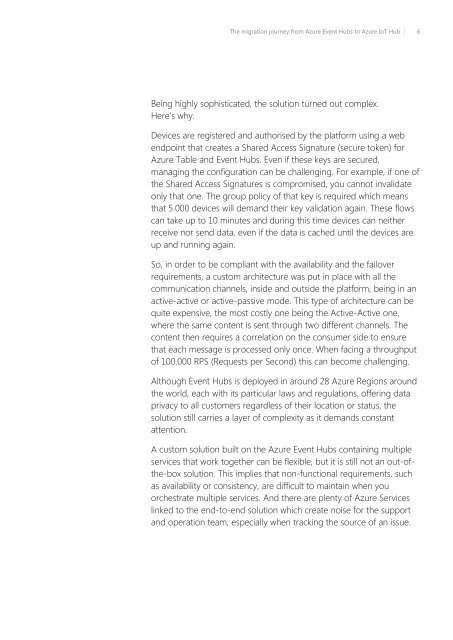JOURNEY FROM AZURE EVENT HUBS TO AZURE IOT HUB
IoT-iQuest-Whitepaper
IoT-iQuest-Whitepaper
You also want an ePaper? Increase the reach of your titles
YUMPU automatically turns print PDFs into web optimized ePapers that Google loves.
The migration journey from Azure Event Hubs to Azure IoT Hub 6<br />
Being highly sophisticated, the solution turned out complex.<br />
Here’s why.<br />
Devices are registered and authorised by the platform using a web<br />
endpoint that creates a Shared Access Signature (secure token) for<br />
Azure Table and Event Hubs. Even if these keys are secured,<br />
managing the configuration can be challenging. For example, if one of<br />
the Shared Access Signatures is compromised, you cannot invalidate<br />
only that one. The group policy of that key is required which means<br />
that 5.000 devices will demand their key validation again. These flows<br />
can take up to 10 minutes and during this time devices can neither<br />
receive nor send data, even if the data is cached until the devices are<br />
up and running again.<br />
So, in order to be compliant with the availability and the failover<br />
requirements, a custom architecture was put in place with all the<br />
communication channels, inside and outside the platform, being in an<br />
active-active or active-passive mode. This type of architecture can be<br />
quite expensive, the most costly one being the Active-Active one,<br />
where the same content is sent through two different channels. The<br />
content then requires a correlation on the consumer side to ensure<br />
that each message is processed only once. When facing a throughput<br />
of 100.000 RPS (Requests per Second) this can become challenging.<br />
Although Event Hubs is deployed in around 28 Azure Regions around<br />
the world, each with its particular laws and regulations, offering data<br />
privacy to all customers regardless of their location or status, the<br />
solution still carries a layer of complexity as it demands constant<br />
attention.<br />
A custom solution built on the Azure Event Hubs containing multiple<br />
services that work together can be flexible, but it is still not an out-ofthe-box<br />
solution. This implies that non-functional requirements, such<br />
as availability or consistency, are difficult to maintain when you<br />
orchestrate multiple services. And there are plenty of Azure Services<br />
linked to the end-to-end solution which create noise for the support<br />
and operation team, especially when tracking the source of an issue.


